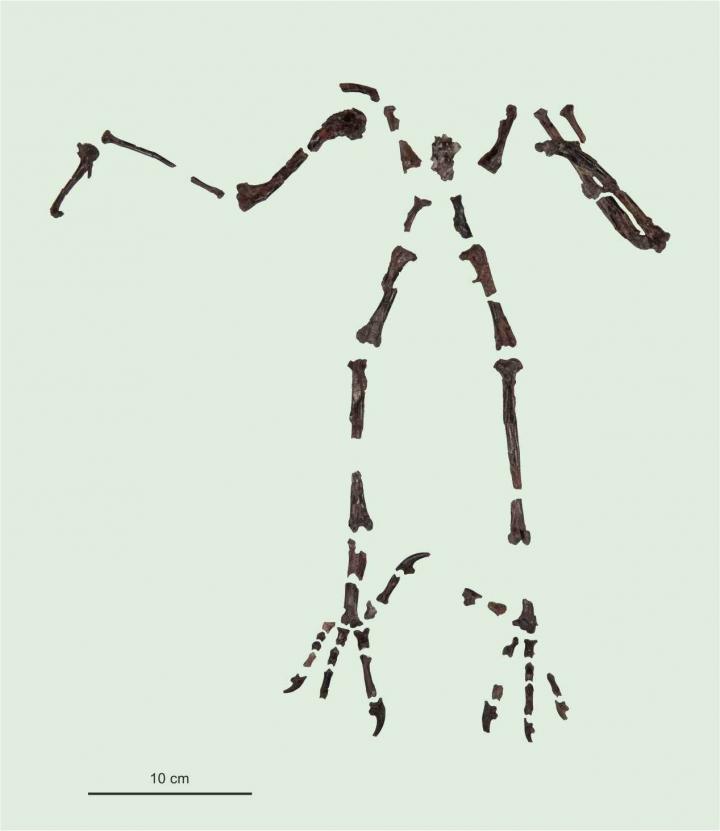
Credit: Senckenberg Research Institute
Paleontologists have described in the Journal of Vertebrate Paleontology a large owl that killed medium-sized mammals with its feet and claws some 55 million years ago. “Today, owls kill with their beak,” says paleontologist Thierry Smith (RBINS), who participated to the study of the well-preserved skeleton from Wyoming, USA. Primoptynx poliotaurus is a new species and a new genus.
The skeleton excavated by American paleontologists at Bighorn Basin in Wyoming thirty years ago, is one of the most complete fossilized owls of the Paleogene, the geological period after the extinction of the non-avian dinosaurs 66 million years ago. The fossil, of which all major postcranial bones have been preserved, is 54.5 to 55 million years old (early Eocene).
Different Toes
Primoptynx poliotaurus was about 50 centimeters in size – comparable to Hedwig, the snowy owl of Harry Potter – and belongs to a group of owls closely related to extinct family Protostrigidae. “Its feet are different from those of today’s owls”, says paleontologist Thierry Smith of the Royal Belgian Institute of Natural Sciences (RBINS), co-author of the study with Gerald Mayr of the Senckenberg Research Institute in Frankfurt and Philip Gingerich of the University of Michigan. “Owls today have four toes with claws of equal size to catch relatively small preys and kill them with the beak. Primoptynx has a longer first and second toe, as seen in hawks and other members of the family Accipitridae. Those more developed toes are used to pin down prey, which are punctured by the talons. So it was an owl that hunted like a hawk on medium-sized mammals.”
This fossil shows – together with other finds – that during the early Eocene there were already many species of owls, of different sizes, which occupied different ecological niches. The success of the owls runs parallel to that of the mammals, which became very diverse after the fifth mass extinction, that wiped out the dinosaurs. The later extinction of Primoptynx poliotaurus and other proto-owls may have been due to the emergence of daytime birds of prey in the Late Eocene.
Discoveries from the early stages of owl evolution are exceedingly rare. An approximately 60-million-year-old leg bone is the oldest fossil that can be assigned to an owl. “Other owls from this time period are also only known on the basis of individual bones and fragments. Therefore, I was especially pleased when I received a largely complete owl skeleton from the North American Willwood Formation for study, which my colleague and the study’s co-author, Philip Gingerich, had discovered 30 years ago,” explains Dr. Gerald Mayr of the Senckenberg Research Institute and Natural History Museum in Frankfurt, Germany.
The newly described animal belongs to a previously unknown, very large species of fossil owl. Except for the skull, all major bones of the 55-million-year-old bird are preserved. “The fossil owl was about the size of a modern Snowy Owl. However, it is clearly distinguished from all extant species by the different size of its talons. While in present-day owls the talons on all toes are approximately the same size, the newly described species Primoptynx poliotauros has noticeably enlarged talons on its hind toe and second toe,” explains Mayr.
These toe proportions are known from modern diurnal raptors, e.g., eagles and goshawks. These birds, which are not closely related to owls, pierce their prey with their sharp talons. Mayr and his colleagues therefore assume that the extinct owl also used its feet to kill its prey. “By contrast, present-day owls use their beak to kill prey items–thus, it appears that the lifestyle of this extinct owl clearly differed from that of its modern relatives,” adds the ornithologist from Frankfurt.
Moreover, the new discovery reveals a high level of diversity among the owls of the early Eocene in North America–from the small species Eostrix gulottai, measuring a mere 12 centimeters, to the newly discovered, roughly 60-centimeter-tall bird.
“It is not clear why owls changed their hunting technique in the course of their evolution. However, we assume that it may be related to the spread of diurnal birds of prey in the late Eocene and early Oligocene, approximately 34 million years ago. Competition for prey with diurnal birds of prey may have triggered feeding specializations in owls, possibly also leading to these charismatic birds’ nocturnal habits,” says Mayr.
###
Media Contact
Simon Wesson
[email protected]




